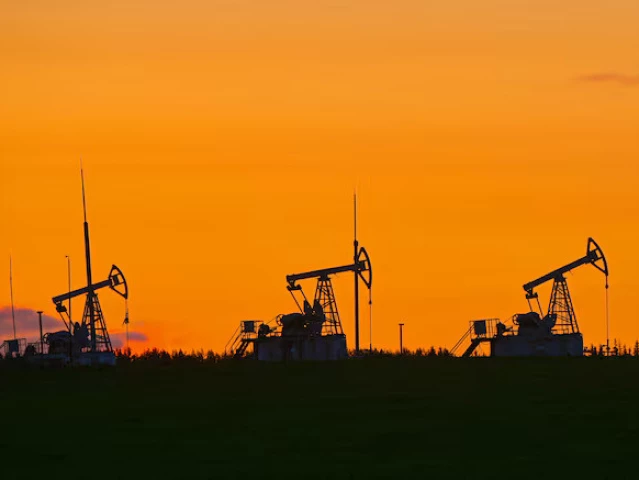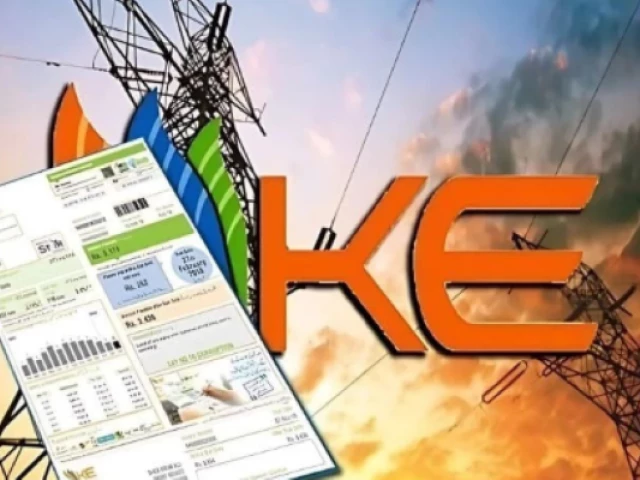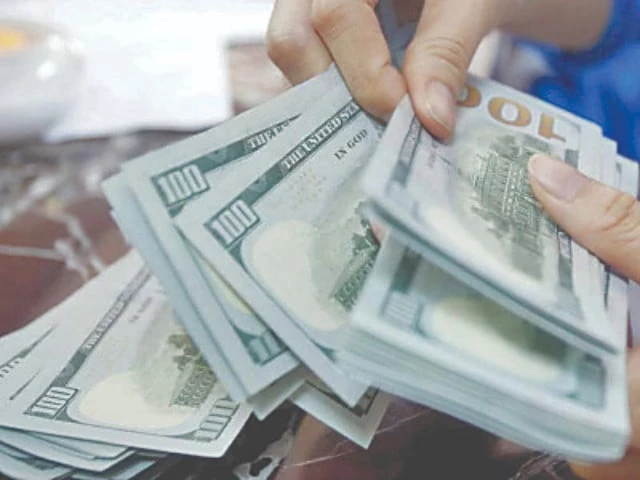Business
PSX turns red as profit-taking drags KSE-100 down 793 points | The Express Tribune
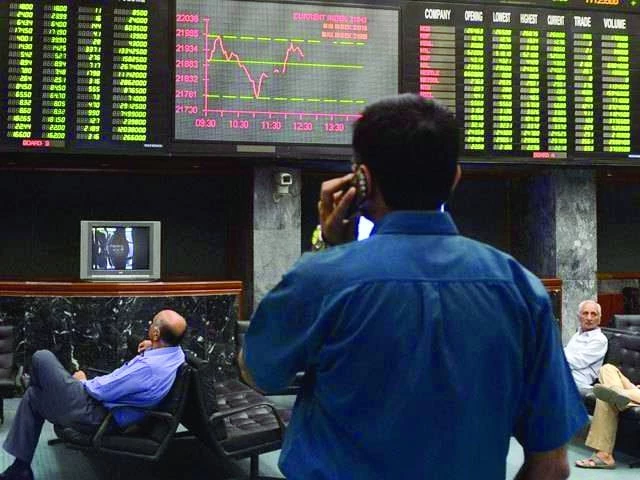
Overall trading volume declined to 1.56 billion shares compared with 1.82 billion day earlier
The Pakistan Stock Exchange witnessed a notable shift in momentum as early gains faded amid aggressive profit-taking during the closing hours, dragging the benchmark KSE-100 index deep into the red by the end of trading.
The session began on a bullish note on Wednesday, buoyed by encouraging corporate earnings and signs of macroeconomic stability. This initial optimism pushed the KSE-100 up by more than 500 points soon after the opening bell, with the index peaking at 168,163.22, its highest level of the day.
However, momentum fizzled as trading progressed. The market entered a sluggish phase, moving sideways for several hours before bearish sentiment took over in the final stretch. A wave of selling — mainly from investors locking in gains — sent the index tumbling to an intra-day low of 166,230.89.
By the close, the KSE-100 had shed 793.56 points, settling at 166,553.28, down 0.47% from the previous day.
Analysts attributed the late-session dip to profit-booking ahead of key economic data releases and possible political developments expected to influence investor sentiment in the coming days. While Wednesday’s sell-off reflected caution, the strong opening suggested underlying investor confidence — a tug-of-war likely to define short-term market trends.
Arif Habib Limited (AHL), in its report, noted that “consolidation into support bodes well for additional gains for the rest of the week.”
Among individual stocks, 38 shares rose while 58 declined. Pakistan Petroleum (+3.21%), Oil and Gas Development Company (+0.87%), and PSX (+5.7%) were the biggest contributors to index gains. In contrast, Fauji Fertiliser (-2.1%), United Bank (-1.11%), and MCB Bank (-1.47%) were the main drags.
In major news, QatarEnergy officials are set to visit Pakistan next week to finalise Islamabad’s request to reduce gas shipments for next year amid weaker demand. Meanwhile, the Securities and Exchange Commission of Pakistan (SECP) approved changes to PSX rules, making it mandatory for companies to hold corporate briefings on their annual financial results.
Ghandhara Automobiles (-2.13%) reported 1QFY26 EPS of -Rs29.33, a year-on-year increase of 178%, in line with expectations. Similarly, MCB Bank (-1.47%) posted 9MCY25 EPS of Rs37.42, down 16% YoY, along with a DPS of Rs27, also matching projections.
AHL anticipated support around the 166,000-point level to hold, expecting renewed buying interest to push the index higher in the coming sessions.
Overall trading volume declined to 1.56 billion shares compared with 1.82 billion a day earlier, while the value of traded shares stood at Rs55.06 billion. A total of 476 companies were traded, of which 203 closed higher, 232 fell, and 41 remained unchanged. K-Electric led volumes with 241 million shares, down Rs0.30 to close at Rs6.21.
Business
Carney: Canada is ready to pick up trade talks when US is ready
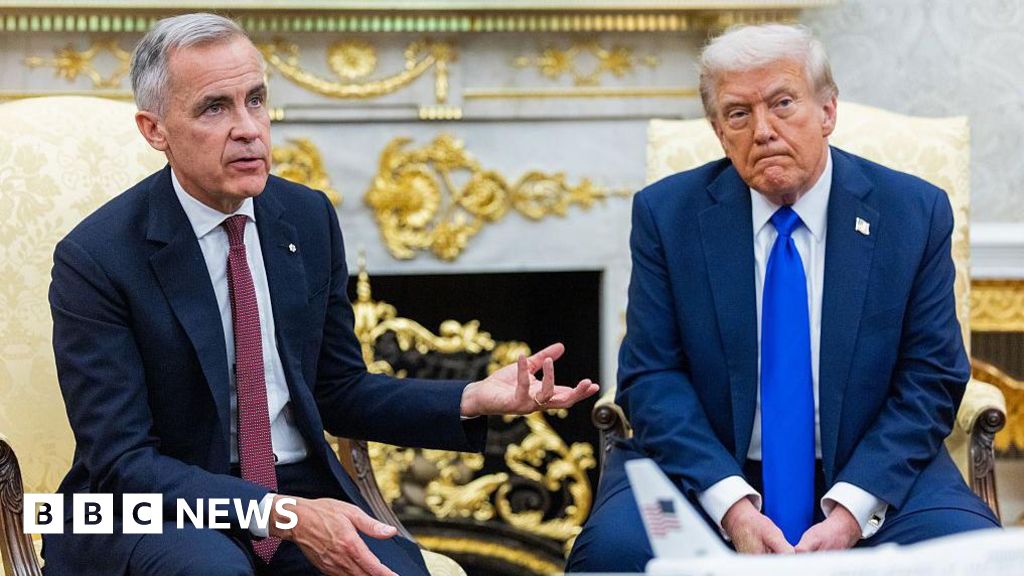
Osmond Chia,Business reporter, and
Maia Davies
Canadian Prime Minister Mark Carney said his country is prepared to resume trade talks with the US “when the Americans are ready.”
His remarks come after US President Donald Trump announced an immediate end to all trade negotiations with Canada over an advert critical of the tariffs he has imposed on the nation.
The advert, sponsored by the Canadian province of Ontario, quotes former US President Ronald Reagan, a Republican and icon of US conservatism, saying tariffs “hurt every American”.
Trump wrote on social media that the advert was “FAKE” and “egregious”, adding that trade talks were “HEREBY TERMINATED”.
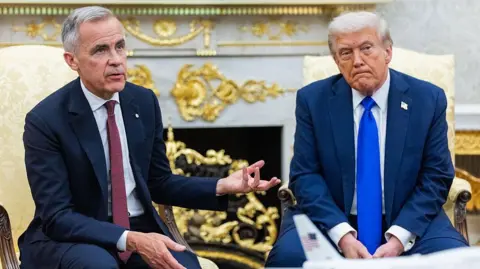 Getty Images
Getty ImagesThe Trump administration has imposed a 35% levy on many Canadian imports, as well as individual tariffs targeting particular industries like car and steel manufacturing. Ontario has been particularly hard-hit by these.
Trump has allowed exemptions for goods that fall under a free trade agreement with Mexico and Canada, negotiated during his first term.
But since his election earlier this year, Canada’s Carney has attempted to strike a deal that would ease the tariffs. Three-quarters of Canadian exports are sold to the US, making its economy particularly vulnerable.
This effort has been complicated by Ontario Premier Doug Ford, who is one of the most vocal critics of the taxes levied on US firms buying Canadian products.
In the minute-long advert published last week, Reagan’s voice can be heard narrating over images that include the New York Stock Exchange and cranes adorned with both US and Canadian flags.
The video excerpts from a 1987 national radio address by Reagan that focuses on foreign trade.
“When someone says, ‘let’s impose tariffs on foreign imports’, it looks like they’re doing the patriotic thing by protecting American products and jobs. And sometimes, for a short while, it works – but only for a short time,” Reagan says in the advert.
“Over the long run, such trade barriers hurt every American, worker and consumer.
“High tariffs inevitably lead to retaliation by foreign countries and the triggering of fierce trade wars… Markets shrink and collapse, businesses and industries shut down and millions of people lose their jobs.”
The Ronald Reagan Foundation – which is charged with preserving his legacy – released a statement on Thursday saying the advert had used “selective” audio and video of the former president’s remarks.
It said the advert “misrepresents” the former president’s address, without specifying why, and accused the Ontario government of not seeking permission to use and edit the remarks.
The foundation said it was “reviewing its legal options”.
Trump referenced this statement, and said the video was designed to “interfere with” the US Supreme Court’s upcoming decision in November on whether Washington’s sweeping tariffs on many nations’ products are legal.
The court’s decision represents the biggest test of Trump’s presidential authority and signature economic policy, potentially forcing the US to refund billions collected in tariffs.
Prime Minister Carney did not address the advertisement in his remarks early on Friday. He said that Canada has made “a lot of progress” in trade talks with the US, but is also focused on “developing new partnerships” with other countries, including Asia.
He spoke as he was departing Canada for the ASEAN summit in Kuala Lumpur. Trump is also expected to attend.
Ford, meanwhile, posted the full Reagan speech on X and wrote: “Canada and the United States are friends, neighbours and allies. President Ronald Reagan knew that we are stronger together.”
While it only includes excerpts from the original, five-minute-long address, it does not alter Reagan’s words.
The order in which he makes the comments has been changed. The advert’s penultimate sentence is taken from near the beginning of his speech, and a phrase that features about halfway through the advert is likewise taken from an earlier point in the address.
The original address – titled Address to the Nation on Free and Fair Trade – is regarding a specific set of tariffs the Reagan administration had at the time imposed on some Japanese goods.
Reagan seeks to use the speech to explain why he introduced the tariffs in this “special case” despite his belief that “imposing such tariffs or trade barriers and restrictions of any kind are steps that I am loath to take”.
He makes clear that he wants to lift them as soon as possible “to promote the prosperity and economic development that only free trade can bring” – a position he stresses throughout the speech.
Trump later doubled down on his criticism of the advert, writing that “Ronald Reagan did not like Tariffs, when actually he LOVED TARIFFS FOR OUR COUNTRY, AND ITS NATIONAL SECURITY”.
Speaking to White House reporters on Friday morning, US National Economic Council Director Kevin Hassett said that “frustration has built up over time” with Canada.
“The Canadians have been very difficult,” he said.
A few minutes earlier, he told Fox Business that “sometimes when you’re frustrated, a time-out is the right call.”
“It’s probably a good time to take a break.”
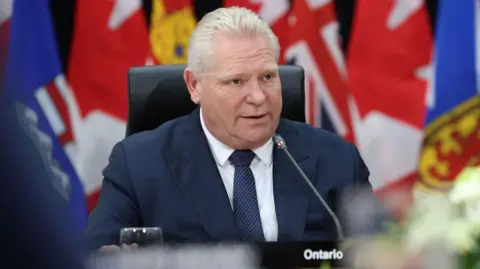 Getty Images
Getty ImagesThe advert was run as part of a campaign worth $75m Canadian dollars (£40m; $54m) on mainstream TV channels in the US.
In a post accompanying the advert last week, Ford wrote that “we’ll never stop making the case against American tariffs on Canada”.
China’s embassy in Washington also used a similar Reagan clip in a post on X to cast doubt on Trump’s global tariffs earlier this year.
Ontario is Canada’s most populous province and its largest regional economy, and has suffered the most as a result of the US tariffs.
Ford hit back at Trump’s earlier tariff threat against Canada by saying he was willing to cut off power supply to the US.
He had also described Washington’s trade policies against Canada as having pulled a knife and “yanked it into us“, and called on US lawmakers to put pressure on Trump.
Trump’s sector-specific levies on Canadian goods include a 50% levy on metals and 25% on automobiles.
The White House’s global tariffs – particularly on steel, aluminium and cars – have hit Canada hard, forcing job losses and putting pressure on businesses.
It is the second time Trump has said he was ceasing trade talks with Canada, after Ottawa announced it would impose a digital services tax on US technology firms earlier this year.
When Canada rescinded the tax, the White House said Carney had “caved” to pressure from Trump.
Business
Tata Group Tussle: What’s Behind The Boardroom Rumblings And Tata Sons Listing Row
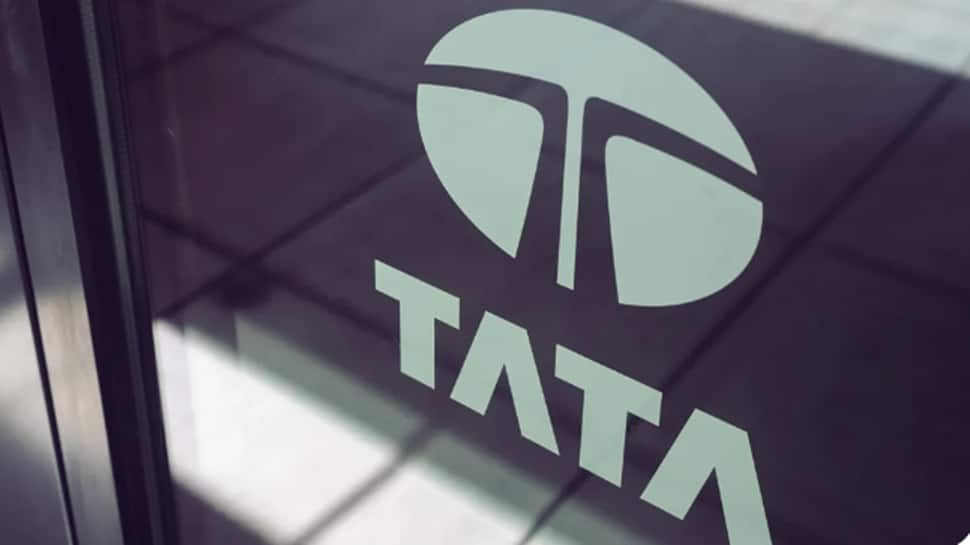
The Tata Group, one of India’s largest and most respected business conglomerates, is facing growing internal differences over whether its parent company, Tata Sons, should be listed on the stock market. Tata Sons is the unlisted holding company that controls the Tata Group’s vast network of businesses — including Tata Steel, Tata Motors, Tata Consultancy Services, and Air India. According to its 2024–25 annual report, it holds stakes in 355 subsidiaries, 39 joint ventures, and 48 associate companies, and received Rs 36,149 crore in dividends from them last year, reported Mint
Because Tata Sons is unlisted, its shareholders cannot easily sell or “monetize” their holdings. The SP Group, which has been part of Tata Sons since the 1930s, has long wanted a listing to unlock the value of its stake — estimated between Rs 1.5 trillion and Rs 3 trillion, said reports.
The Core Dispute
The SP Group’s demand for listing gained momentum after its representative, Cyrus Mistry, was removed as Tata Sons chairman in 2016, a move that led to a bitter legal and personal fallout between the two groups.
The SP Group, which faces significant debt in its construction and infrastructure businesses, sees the listing as a way to raise funds and strengthen its finances. Earlier this year, credit rating agency ICRA reaffirmed a ‘BBB’ rating with a negative outlook for Shapoorji Pallonji and Company Pvt. Ltd., pointing to continued pressure on liquidity, said reports.
In contrast, Tata Trusts, which uses its dividends from Tata Sons to fund large-scale philanthropic projects, has no such financial pressure. In 2024–25, it disbursed Rs 902 crore in grants, with most funds directed to social and institutional programs. The Trusts also influence key decisions within Tata Sons, including top appointments and governance matters, and want the group to retain its private, long-term structure. Meanwhile, as per PTI reports, Tata Trusts has circulated a proposal to reappoint Mehli Mistry as a trustee for three of its key philanthropic bodies, a move that would make him a lifetime trustee.
RBI’s Role and the Listing Deadline
The Reserve Bank of India (RBI) added to the tension in September 2022, when it classified Tata Sons as an “upper-layer” non-banking financial company (NBFC) — a category that required the company to list its shares within three years, by September 2025.
However, Tata Sons moved to avoid that requirement by retiring debt and surrendering its NBFC licence earlier this year. This would allow it to remain a privately held company. The company is currently awaiting RBI’s approval for its deregistration.
The RBI’s silence on the matter since then has raised eyebrows among market watchers, with some questioning whether the central bank will enforce the original listing rule or allow Tata Sons to remain private.
What’s At Stake
According to experts, for the SP Group, listing Tata Sons could unlock much-needed value and ease its debt burden. In a recent statement, the group called the listing a “moral and social imperative,” arguing that it would “unlock immense value for over 1.2 crore shareholders of listed Tata companies who indirectly have a stake in Tata Sons.”
The Shapoorji Pallonji (SP) Group has renewed its call for public listing. In a strongly worded statement, the group described the IPO as “a moral and social imperative”, saying it would “unlock immense value for over 1.2 crore shareholders of listed Tata companies.
For Tata Trusts, however, a public listing could mean less control over the company that anchors the entire Tata empire. The Trusts’ leadership believes the current structure — where dividends from Tata companies fund its philanthropic work — best preserves the vision of Jamsetji Tata, the group’s founder, noted analysts.
Business
Emissions from UK residents and businesses fell by 0.5% in 2024, data shows

Greenhouse gas emissions generated by UK residents and businesses both at home and abroad fell by 0.5% in 2024, provisional figures show.
The Office for National Statistics (ONS) said on Friday that the UK’s so-called “residential basis” emissions were 476 million tonnes of carbon dioxide equivalent (CO2e) in 2024.
This was 43.3% below levels in 1990 – the first year the ONS has data for.
Residence basis emissions cover those generated by British residents and businesses regardless of where they occur geographically.
The 0.5% fall from 2023 continues a general downward trend since the data time series began in 1990.
The manufacturing industry was the largest contributor to this total decrease in 2024, falling by 7.4% from 2023, according to the ONS.
Meanwhile, consumer spending remained the largest single contributor to UK emissions on a residence basis, at 26.0% of the 2024 UK total, the figures show.
These emissions were found to have risen by 1.7% in 2024 compared with 2023, marking the first time annual consumer expenditure emissions have increased since 2021, during the coronavirus pandemic.
This rise was largely driven by a 4.1% increase in residential natural gas combustion, the ONS said.
The second largest contributor to the UK’s emissions last year was found to be the transport sector at 16.1%.
It came after emissions from this industry increased by 4.5% in 2024, continuing a general rise for transport since 2021.
The ONS also published figures on changes in UK emissions intensity – which measures environmental efficiency by comparing the quantity of emissions to the economic output.
Between 2023 and 2024, UK emissions intensity fell from 0.16 to 0.15 thousand tonnes of CO2e per million pounds of gross value added (GVA).
Residence basis emissions, which are published by the ONS, can include emissions generated by UK residents overseas, such as travel, and from UK-registered companies operating abroad but they exclude those generated within the UK by foreign residents and businesses.
They differ from the Energy Department’s (Desnz) figures – last released in March – that calculate the emissions generated within the UK’s borders.
In 2024, these territorial emissions were 371.4 million tonnes of carbon equivalent – which was 3.5% lower than 2023 and 54.2% lower than 1990.
-

 Tech1 week ago
Tech1 week agoWhy the F5 Hack Created an ‘Imminent Threat’ for Thousands of Networks
-

 Tech5 days ago
Tech5 days agoHow to Protect Yourself Against Getting Locked Out of Your Cloud Accounts
-
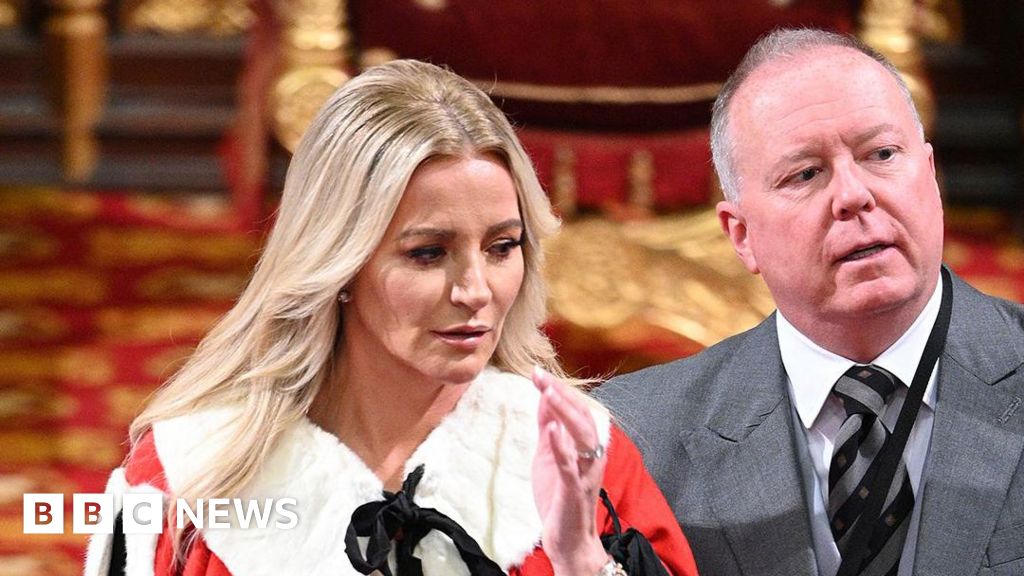
 Business1 week ago
Business1 week agoBaroness Mone-linked PPE firm misses deadline to pay £122m
-

 Sports1 week ago
Sports1 week agoU.S. Soccer recommends extending NCAA season
-

 Sports6 days ago
Sports6 days agoPCB confirms Tri-nation T20 series to go ahead despite Afghanistan’s withdrawal – SUCH TV
-

 Tech6 days ago
Tech6 days agoI Tested Over 40 Heat Protectant Sprays to Find the Best of the Best
-

 Tech1 week ago
Tech1 week agoSpit On, Sworn At, and Undeterred: What It’s Like to Own a Cybertruck
-

 Tech6 days ago
Tech6 days agoUS court bars NSO Group from installing spyware on WhatsApp



